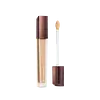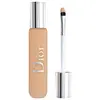Hourglass Cosmetics Vanish Airbrush Concealer Versus Dior Backstage Face & Body Flash Perfector Concealer
What's inside
What's inside
 Key Ingredients
Key Ingredients

 Benefits
Benefits

 Concerns
Concerns

 Ingredients Side-by-side
Ingredients Side-by-side

Water
Skin ConditioningCyclopentasiloxane
EmollientPhenyl Trimethicone
Skin ConditioningMica
Cosmetic ColorantButylene Glycol
HumectantCetyl PEG/PPG-10/1 Dimethicone
EmulsifyingPvp
Emulsion StabilisingPEG-10 Dimethicone
Skin ConditioningCI 77120
Cosmetic ColorantSodium Chloride
MaskingVinyl Dimethicone/Methicone Silsesquioxane Crosspolymer
Aluminum Hydroxide
EmollientCamellia Sinensis Leaf Extract
AntimicrobialCentella Asiatica Extract
CleansingChamomilla Recutita Flower Extract
MaskingDimethicone
EmollientDisteardimonium Hectorite
StabilisingGlycyrrhiza Glabra Root Extract
BleachingMethicone
EmollientMyristic Acid
CleansingPalmitic Acid
EmollientPolygonum Cuspidatum Root Extract
AntioxidantPolysilicone-11
Rosmarinus Officinalis Leaf Extract
AntimicrobialScutellaria Baicalensis Root Extract
AstringentSqualane
EmollientStearic Acid
CleansingTriethoxycaprylylsilane
Chlorphenesin
AntimicrobialPhenoxyethanol
PreservativeCI 77891
Cosmetic ColorantIron Oxides
Water, Cyclopentasiloxane, Phenyl Trimethicone, Mica, Butylene Glycol, Cetyl PEG/PPG-10/1 Dimethicone, Pvp, PEG-10 Dimethicone, CI 77120, Sodium Chloride, Vinyl Dimethicone/Methicone Silsesquioxane Crosspolymer, Aluminum Hydroxide, Camellia Sinensis Leaf Extract, Centella Asiatica Extract, Chamomilla Recutita Flower Extract, Dimethicone, Disteardimonium Hectorite, Glycyrrhiza Glabra Root Extract, Methicone, Myristic Acid, Palmitic Acid, Polygonum Cuspidatum Root Extract, Polysilicone-11, Rosmarinus Officinalis Leaf Extract, Scutellaria Baicalensis Root Extract, Squalane, Stearic Acid, Triethoxycaprylylsilane, Chlorphenesin, Phenoxyethanol, CI 77891, Iron Oxides
Water
Skin ConditioningPhenyl Trimethicone
Skin ConditioningIsododecane
EmollientDimethicone
EmollientMethyl Trimethicone
Skin ConditioningGlycerin
HumectantMica
Cosmetic ColorantAcrylates/Dimethicone Copolymer
Skin ConditioningCetyl PEG/PPG-10/1 Dimethicone
EmulsifyingPEG-9 Polydimethylsiloxyethyl Dimethicone
EmulsifyingButylene Glycol
HumectantTrimethylsiloxysilicate
EmollientTrimethyl Pentaphenyl Trisiloxane
EmollientSodium Myristoyl Glutamate
CleansingDisteardimonium Hectorite
StabilisingPolysilicone-11
Synthetic Fluorphlogopite
Caprylyl Glycol
EmollientButyrospermum Parkii Butter
Skin ConditioningGlyceryl Undecyl Dimethicone
Propylene Carbonate
SolventLecithin
EmollientSodium Benzoate
MaskingAluminum Hydroxide
EmollientHexadecene
SolventCaffeine
Skin ConditioningHydroxyacetophenone
AntioxidantParfum
MaskingAscorbyl Glucoside
AntioxidantTocopherol
AntioxidantTin Oxide
AbrasiveCitric Acid
BufferingPentaerythrityl Tetra-Di-T-Butyl Hydroxyhydrocinnamate
AntioxidantCI 77891
Cosmetic ColorantCI 77491
Cosmetic ColorantCI 77492
Cosmetic ColorantCI 77499
Cosmetic ColorantWater, Phenyl Trimethicone, Isododecane, Dimethicone, Methyl Trimethicone, Glycerin, Mica, Acrylates/Dimethicone Copolymer, Cetyl PEG/PPG-10/1 Dimethicone, PEG-9 Polydimethylsiloxyethyl Dimethicone, Butylene Glycol, Trimethylsiloxysilicate, Trimethyl Pentaphenyl Trisiloxane, Sodium Myristoyl Glutamate, Disteardimonium Hectorite, Polysilicone-11, Synthetic Fluorphlogopite, Caprylyl Glycol, Butyrospermum Parkii Butter, Glyceryl Undecyl Dimethicone, Propylene Carbonate, Lecithin, Sodium Benzoate, Aluminum Hydroxide, Hexadecene, Caffeine, Hydroxyacetophenone, Parfum, Ascorbyl Glucoside, Tocopherol, Tin Oxide, Citric Acid, Pentaerythrityl Tetra-Di-T-Butyl Hydroxyhydrocinnamate, CI 77891, CI 77491, CI 77492, CI 77499
 Reviews
Reviews

Ingredients Explained
These ingredients are found in both products.
Ingredients higher up in an ingredient list are typically present in a larger amount.
Aluminum Hydroxide is a form of aluminum. It can be naturally found in nature as the mineral gibbsite. In cosmetics, Aluminum Hydroxide is used as a colorant, pH adjuster, and absorbent.
As a colorant, Aluminum Hydroxide may add opacity, or reduce the transparency. Aluminum hydroxide is contains both basic and acidic properties.
According to manufacturers, this ingredient is an emollient and humectant. This means it helps hydrate the skin.
In medicine, this ingredient is used to help relieve heartburn and help heal ulcers.
There is currently no credible scientific evidence linking aluminum hydroxide in cosmetics to increased cancer risk.
Major health organizations allow the use of aluminum hydroxide in personal care products and have not flagged it as a carcinogenic risk at typical usage levels.
Learn more about Aluminum HydroxideButylene Glycol (or BG) is used within cosmetic products for a few different reasons:
Overall, Butylene Glycol is a safe and well-rounded ingredient that works well with other ingredients.
Though this ingredient works well with most skin types, some people with sensitive skin may experience a reaction such as allergic rashes, closed comedones, or itchiness.
Learn more about Butylene GlycolThis ingredient is a high molecular weight silicone. It has emulsifying and skin conditioning properties.
Ci 77891 is a white pigment from Titanium dioxide. It is naturally found in minerals such as rutile and ilmenite.
It's main function is to add a white color to cosmetics. It can also be mixed with other colors to create different shades.
Ci 77891 is commonly found in sunscreens due to its ability to block UV rays.
Learn more about CI 77891Dimethicone is a type of synthetic silicone created from natural materials such as quartz.
What it does:
Dimethicone comes in different viscosities:
Depending on the viscosity, dimethicone has different properties.
Ingredients lists don't always show which type is used, so we recommend reaching out to the brand if you have questions about the viscosity.
This ingredient is unlikely to cause irritation because it does not get absorbed into skin. However, people with silicone allergies should be careful about using this ingredient.
Note: Dimethicone may contribute to pilling. This is because it is not oil or water soluble, so pilling may occur when layered with products. When mixed with heavy oils in a formula, the outcome is also quite greasy.
Learn more about DimethiconeDisteardimonium Hectorite comes from the clay mineral named hectorite. It is used to add thickness to a product.
It can also help stabilize a product by helping to disperse other ingredients.
Hectorite is a rare, white clay mineral.
Learn more about Disteardimonium HectoriteMica is a naturally occurring mineral used to add shimmer and color in cosmetics. It can also help improve the texture of a product or give it an opaque, white/silver color.
Serecite is the name for very fine but ragged grains of mica.
This ingredient is often coated with metal oxides like titanium dioxide. Trace amounts of heavy metals may be found in mica, but these metals are not harmful in our personal products.
Mica has been used since prehistoric times throughout the world. Ancient Egyptian, Indian, Greek, Roman, Aztec, and Chinese civilizations have used mica.
Learn more about MicaPhenyl Trimethicone is a silicon-based polymer. It is derived from silica.
Phenyl Trimethicone is used as an emollient and prevents products from foaming.
As an emollient, it helps trap moisture in the skin. It is considered an occlusive.
Learn more about Phenyl TrimethiconePolysilicone-11 is a film-forming silicone that creates a non-tacky and matte finish on the skin. It's commonly used to improve texture, absorb excess oil, and help active ingredients spread evenly.
Due to its "rubber-like" structure, it stays on the skin's surface instead of being absorbed. On the skin, it creates a flexible layer that enhances wearability and stability.
Water. It's the most common cosmetic ingredient of all. You'll usually see it at the top of ingredient lists, meaning that it makes up the largest part of the product.
So why is it so popular? Water most often acts as a solvent - this means that it helps dissolve other ingredients into the formulation.
You'll also recognize water as that liquid we all need to stay alive. If you see this, drink a glass of water. Stay hydrated!
Learn more about Water